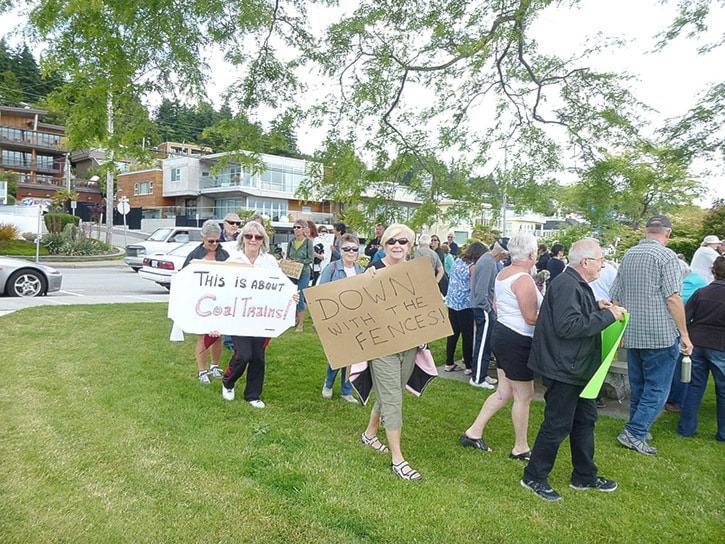Some 75 people gathered near the promenade on White Rock’s West Beach at noon Friday to protest recent fencing off of access to the beach due to rail-safety concerns.
The gathering was held in Bayview Park, a stone’s throw from the rail crossing to the boat launch, which was blocked off with a padlocked fence two weeks ago, only to be unblocked Thursday after widespread protest.
Organizer and community activist Pat Petrala led the crowd in chants of “we will, we will rock you” at the rally – one of three held at the location that day.
Two clear messages emerged for the City of White Rock, Transport Canada and the BNSF at the protest: residents are angry that access to the beach has been restricted; and participants strongly favour relocating the BNSF line to an inland route.
A six-foot, locked gate that the city believed to be mandatory – due to a Transport Canada safety order – was removed Thursday, after a senior official with the federal body made it clear that all he wanted was assurances that safety measures to protect pedestrians would be put in place as soon as possible.
“It only cost us $2,000,” rail opponent Susan Potzold told the crowd about the exercise.
“Plus staff wages,” Petrala interjected.
Other fencing is still being installed along the waterfront and at the foot of the Coldicutt steps, to address what the U.S.-based BNSF says is the worst trespassing problem on its routes throughout the Pacific Northwest.
Advocates of relocation said fencing off the line won’t address concerns about hazardous goods being carried through White Rock – including oil, propane and chlorine – and the health impacts of dust from uncovered coal trains. Fencing the line will only encourage more – and more dangerous – trespassing, they added.
Potzold said population density in White Rock is another reason the community deserves special consideration.
“If they get these fences, they’ll be able to put even more trains through, even faster,” Potzold said. “BNSF will be laughing all the way to the bank.”
Former MLA and councillor Ken Jones, an advocate of relocation, said the current route doesn’t effectively serve the railway’s needs.
“The roadbed isn’t stable; they can’t have a double track and they have problems with mudslides,” he said.
Jones added that relocation advocates have identified a more logical route that would travel up through Campbell Heights “along the edge of the ALR” and connect with the existing line in the Colebrook Road area.
Jones, like other speakers, noted White Rock’s beach is a recreational area of significance to the entire region.
“Don’t buy the argument that this is just us not wanting something in our own backyard,” he told the crowd.
Also attending the meeting was White Rock Coun. Grant Meyer – who told protesters he believed that Transport Canada and the BNSF had “got the message that beach access is important to residents.”
Resident Jan Miller said that while she’s convinced that relocation is the most desirable goal, some interim measures to establish safe, level line-crossings that allow access to the beach need to be taken.
“We’ve been talking about relocation for 40 years,” she reminded the crowd. “But we reduced it from four rails, and all the shunting. All (Transport Canada) wants is spring gates and crossings that are level.”
Typical of residents angry about restricted beach access was Nancy Cadenhead, 84, who said she needs beach access close to home because of mobility problems.
“This (the boat launch crossing) is the only way I can get to the beach,” she said.
“I was 10 years old when I first came down here from Vancouver with my parents. Now I live here and I have grandchildren and great-grandchildren, and we all come down to the beach. I’ve never rallied on anything before, but this has rattled me – when they put that fence in it did me in.”
